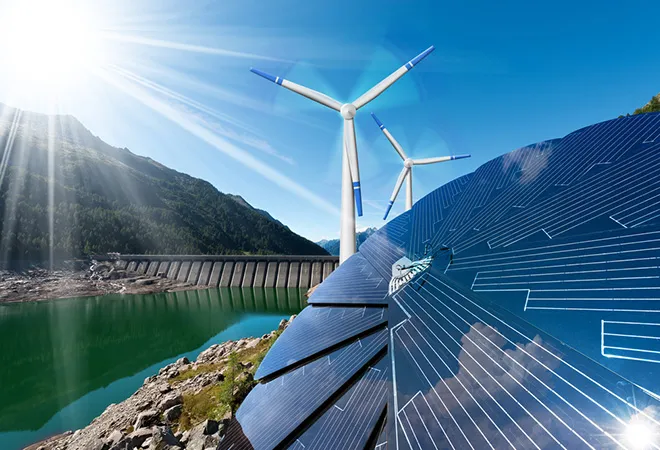
Developing countries
need US$ 1 trillion of green capital per annum in the renewable energy (RE) sector alone by 2030 to meet their net-zero targets, according to the International Monetary Fund (IMF). However, the total
capital mobilised in the RE sector was less than US$ 495 billion in 2022; most of this mobilisation was restricted to the developed countries. This is
not in line with the commitments made in the Paris Conference of Parties (COP) 21.
Developing countries struggle to raise the required amount of capital efficiently and quickly due to the smaller size of their economies, limited financial savings, limited fiscal power, and the need for significant investment in other strategic areas. Moreover, several developing countries are already under a severe debt burden that has crippled their abilities to raise more public capital for climate actions, including investment in the revenue-generating RE sector. Without a large-scale intervention by multilateral and bilateral institutions, it is nearly impossible for developing countries to mobilise the required amount of capital to meet their clean energy needs. On the other side, several developing countries rely heavily on fossil fuels for their energy generation ramp-up plans to cater to their economic growth agendas. Hence, the active participation of developing countries in the clean energy transition is crucial. This will strengthen global efforts to decarbonise the energy sector and consequently help achieve its net-zero targets.
Banking finance: Not the most efficient for the RE sector
The RE sector needs long-term debt funding. As the cost of debt funding is lower than equity in most cases, it brings down the cost of funding, thereby, making RE tariff competitive. Banks are not modelled for long-term financing as their liability duration acceptance is relatively short. Typically, banks would prefer financing selective RE projects for the medium term. They tend to renew such loans for additional terms unless the asset quality significantly deteriorates. However, the revised terms of credit depend on the credit quality of assets and the prevailing interest rates. Such a change in terms of credit, including an increase in interest rate, may expose borrowers (RE project developers) to refinancing risk. Thus, developers typically wish to avoid using medium-duration loans and prefer to lock in interest rates for the longest time possible.
Without a large-scale intervention by multilateral and bilateral institutions, it is nearly impossible for developing countries to mobilise the required amount of capital to meet their clean energy needs.
In reality, banks in developing countries are already heavily exposed to long-term infrastructure assets. Hence, they have exhausted their resources in meeting the long-term funding needs of the RE sector. Besides, banks have to charge a higher interest rate on long-term loans as risk weightage is higher for long-term assets, due to the BASEL framework, compared to short-term assets. Thus, the capital market remains the only option on the table to solve the long-term debt funding requirement of the RE sector.
Preference of the capital market
Capital markets can offer efficient long-term debt financing solutions at a reasonable rate to the RE sector. The primary financers in the capital market can be
large institutional investors such as pension and insurance companies, presently holding more than US$100 trillion of assets under management. These two sets of investors need long-duration and low-risk assets with predictable cash flows to meet long-duration predictable liabilities. They prefer to invest in liquid securities and low-risk traded fixed-income securities to meet their long-duration liabilities. Here, the RE sector can offer a solution; this sector is typically capital-intensive at the construction and development stage, followed by very low annual fixed and variable costs along with a contractual revenue structure. This allows it to offer reasonably steady, low-risk, and long-term cash flows. This allows for a match between institutional investors’ investment characteristics. Thus, presently, more than half of the proceeds of green bonds targeting institutional investors are used to finance the RE sector.
Solving the credit rating challenge in developing countries
The credit rating of RE bonds can turn out to be low in the financial markets. Thus, low risk-seeking large institutional investors in developed countries, such as pension funds and insurance companies, may be averse to buying these debt securities issued by RE developers in developing countries. Here, Multilateral Development Banks (MDBs), Development Finance Institutions (DFIs), and similar public financial institutions can play an important role. They can offer partial credit guarantees (PCG) so that the credit rating of these bonds can be upgraded. Such guarantees by AAA-rated global public financial institutions such as the World Bank and Asian Development Bank can make the loan asset less risky, resulting in its credit rating improvement. The quantum of the guarantee can be changed over the years. As the risk may materialise in the long term, guarantee coverage may increase with the passage of time to mitigate long-term risk. Credit guarantee by public financial institutions sends a positive signal to private investors about the bankability of the project. The investors will also be ensured that corporate governance issues are held at bay and political risk is controlled.
The primary financers in the capital market can be large institutional investors such as pension and insurance companies, presently holding more than US$100 trillion of assets under management.
The multiplier effect of a guarantee is bigger than the loan and technical assistance
The amount of capital that the public financial institutions currently have will not be enough to meet the funding needs of the entire RE sector globally. One of the ways to increase capital flows is by leveraging its balance sheet by offering PCG. As a result, a multiplying effect is triggered as compared to a vanilla loan and/or equity. Now, the mobilisation of large-scale private capital is possible by optimally deploying public capital. MDBs and DFIs need to disburse capital only when a guarantee is triggered—in case there is a default of bonds. This means that DFIs and MDBs do not have to deploy a large amount of capital upfront. It will only be summoned when a guarantee is triggered. As several RE projects in developing countries have political and regulatory risks, MDBs and DFIs also have the advantage of preventing developing countries from defaulting on their bonds or taking any decision that leads to the default of loans.
Exponentially increasing the impact of guarantees
It is proposed that the deployment of financial guarantees can be further optimised beyond a partial credit guarantee. When it comes to renewable energy, it is a well-understood fact that such investments yield returns in the form of active cash flows during the life of the project. Also, increasingly, the liquidity of such investments/assets is high as there are several project developers in the market interested in taking over stressed/defunct assets. Thus, in projects where the climate action interventions yield cash flows and/or have intrinsic value, it is wise for the MDB/DFIs to provide a partial credit guarantee only for the interest component of the debt. Such an approach will help pool in more private sector investments while freeing up MDB/DFI capital for a larger number of diverse climate action projects globally. This is also in line with the function of the MDB/DFIs to act as a magnet to attract multiple stakeholders and stimulate interaction between them.
As several RE projects in developing countries have political and regulatory risks, MDBs and DFIs also have the advantage of preventing developing countries from defaulting on their bonds or taking any decision that leads to the default of loans.
Since MDBs and DFIs have a higher appetite to take risks in comparison to private capital, they should focus on de-risking projects to attract private capital for climate action. To remain relevant, MDB and DFIs should re-calibrate their capital deployment strategy. By serving as a bridge between adaptation/mitigation projects and private investors, risk-mitigating instruments like partial credit guarantees can contribute towards delivering climate justice to developing countries.
The views expressed above belong to the author(s). ORF research and analyses now available on Telegram! Click here to access our curated content — blogs, longforms and interviews.



 Developing countries
Developing countries  PREV
PREV



